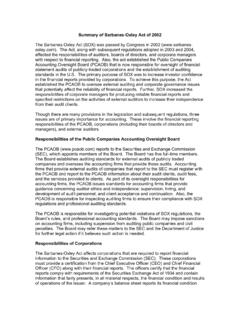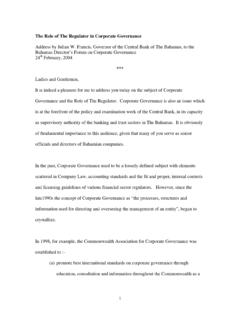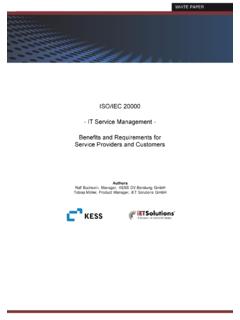Transcription of Valuation International implications of the services …
1 Building and enforcing intellectual property value 200763On August 4 2006 the US Internal Revenue Service (IRS)issued the Temporary Regulations 2006 dealing withtransfer pricing for services . The 2006 regulations, whichare generally effective from January 1 2007, consist offour major components: a comprehensive set of new rules regarding transferpricing for services ; modified rules for determining the ownership ofintangibles, along with a new set of rules fordetermining arm s-length compensation to entitiesother than the owner of an intangible whoseactivities enhance the value of the intangible; additional guidance on when the IRS can determinecontractual terms from the economic substance of aninter-company arrangement in cases where theparties have failed to specify explicit contractualterms.
2 And modified rules for allocation of stewardship expensesthat conform the existing rules to the new rulesgoverning IRS scheduled a public hearing for October 272006, with comments from interested parties due byNovember 2 aspects of the new regulations are likely to beseen as improvements on the proposed Regulations onthe Treatment of services under Section 482; Allocation ofIncome and Deductions From Intangibles (68 Fed Reg53448, September 10 2003), which they replace, whileothers are likely to be viewed less chapter focuses on one of the most important,and potentially controversial, features of the 2006regulations the services cost method (SCM), which isintended to replace the cost-based safe harbour for non-integral services under the current regulations, andwhich supplants the simplified cost-based method setout in the 2003 of SCMThe SCM is a new method for determining an arm s-length charge for the performance of services by onerelated party for another.
3 It tests whether an inter-company charge is consistent with the arm s-lengthstandard by comparing the actual charge to the cost ofthe services without a mark-up. Thus, it effectivelyrequires that services be charged out without a , the 2006 regulations state that when all theconditions for the use of the SCM are met, it is deemed tobe the best order to understand the SCM, it is useful tounderstand the historical context in which it 1968 regulations regarding services containedprovisions that, while not explicitly labelled as a safeharbour, allowed taxpayers to elect to charge out certainroutine services at cost. If services were not found to beintegral under one or more of four alternative tests, thenreimbursement of cost was presumed to be an arm s-length charge unless the taxpayer demonstrated thatsome other charge was more appropriate.
4 In general, thisregime seemed to work well for most taxpayers. Itworked particularly well in mitigating the tensionbetween US rules that allow for charge-outs at cost andnon-US rules that generally require a mark-up for allservices that provide a benefit to the recipient. Inoutbound cases (where a US taxpayer performs servicesfor a non-US taxpayer), a US service provider wouldtypically avail itself of the safe harbour; in inbound cases(where a non-US taxpayer performs services for a UStaxpayer), the non-US service provider would charge amark-up, with the US service recipient relying on acomparables-based transfer-pricing study to show theValuationInternational implications of theservices cost method of the new UStransfer pricing regulationsDuff & PhelpsPaul B BurnsIRS that the mark-up required under non-US law wasmore appropriate than a charge-out at time the IRS became concerned that some UStaxpayers were abusing the flexibility provided by the1968 regime by charging out high value-added servicesat cost.
5 Thus, in the 2003 proposed regulations the IRSproposed replacing the safe harbour with the simplifiedcost-based method. However, the overwhelming volumeof negative comments on this method caused the IRS toreconsider, and ultimately scrap, this 2006 regulations attempt to balance twocompeting considerations in developing a new methodfor pricing certain types of service. The IRS remainsconcerned about what it perceives as manipulation of the1968 regulations by multinational groups; on the otherhand, it recognises that it is in the interest of sound taxadministration to lessen the compliance burden ontaxpayers with respect to intragroup back-officeservices that are common across to the extent that the arm s lengthmark-ups are low and the activities do not significantlycontribute to business success or failure.
6 The result ofthis balancing act is the best way to conceptualise the SCM is to think interms of a four-part test, all four parts of which must besatisfied in order for the SCM to , the services in question must be coveredservices as defined in Section (b)(4) of theTemporary Regulations 2006. These can be eitherspecified covered services or low-margin coveredservices. Specified covered services are categories ofservice that the IRS designates in a revenue procedure(sometimes referred to as the whitelist) based upon thecommissioner s determination that the specified coveredservices are support services common among taxpayersacross industry sectors and generally do not involve asignificant median comparable mark-up on total servicescosts.
7 The IRS has issued and requested comments frominterested parties on a proposed revenue procedure thatidentifies 48 categories of specified covered service. Low-margin covered services are services for which thetaxpayer can show that the median comparable mark-upon total services costs is seven per cent or , the taxpayer s books and records must beadequate to permit verification by the commissioner ofthe total services costs incurred by the [serviceprovider] and must include a statement evidencing thetaxpayer s intention to apply the services cost method .While this seems straightforward enough, sometaxpayers may face difficulties in implementing changesto accounting systems and procedures prior to theeffective date, and this rule is more challenging than itfirst , the services in question must not relate to atransaction that is on a nine-item blacklist: manufacturing; production; extraction, processing or exploration of naturalresources; construction; distribution, sales or purchasing agency activities or acting under a commission or other similararrangement ; research and development activities; engineering or scientific activities; financial transactions, including guarantees.
8 Or curious drafting of the blacklist rule, in whichtransactions, rather than services , are deemed not to becovered services , creates interesting interpretive , in order for the SCM to apply the taxpayermust reasonably [conclude] in its business judgementthat the covered services do not contribute significantlyto key competitive advantages, core competencies orfundamental risks of success or failure in one or moretrades or businesses of the [service provider], therecipient, or both .If otherwise covered services do contributesignificantly to key competitive advantages, corecompetencies or fundamental risks of success or failure,the SCM is inapplicable and an arm s-length mark-up willbe required. The preamble to the temporary regulationsrecognises that the proper administration of this provisiondepends on IRS field examiners giving appropriatedeference to taxpayers reasonable business challenges and administrative issuesThe consensus of the early commentary on the newregulations seems to be that the SCM is an improvementon the simplified cost-based method.
9 Nevertheless, the2006 regulations present several significant interpretivechallenges and may prove difficult to apply, especially tothe extent that they continue the US rules divergencefrom the International consensus with respect to mark-ups. Some of these issues are explored or elective?Some early commentators on the SCM have expresseduncertainty as to whether its application is mandatory orelective. They have noted a perceived tension betweenthe requirement that taxpayers include in their booksand record a statement of intention to use the SCM, andBuilding and enforcing intellectual property value 200764 Valuation Duff & Phelpsthe notion that if the SCM applies it will be considered tobe the best balance, a better interpretation of the 2006regulations is that the use of the SCM is mandatory,when it applies.
10 However, the SCM can also be seen aseffectively elective, in the sense that it appears thatmultinational groups can structure their way either intoor out of its the hypothetical case of a US-basedmultinational group that engages in the design,manufacture and worldwide sale of gadgets. In thecurrent structure the parent company performs a varietyof whitelisted back-office services both for itself and forits non-US subsidiaries in support of their respectivebusiness activities. If those services are performed by theparent company, it can in good faith reasonablyconclude in its business judgement that the coveredservices do not contribute significantly to keycompetitive advantages, core capabilities or fundamentalrisks of success or failure in its , suppose that for good business reasons theparent drops the back-office functions into a newsubsidiary that does nothing else.




